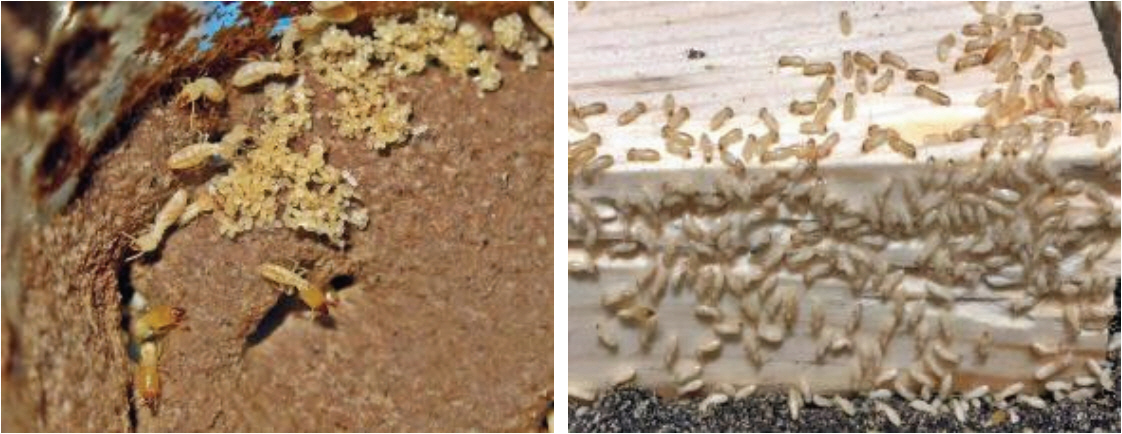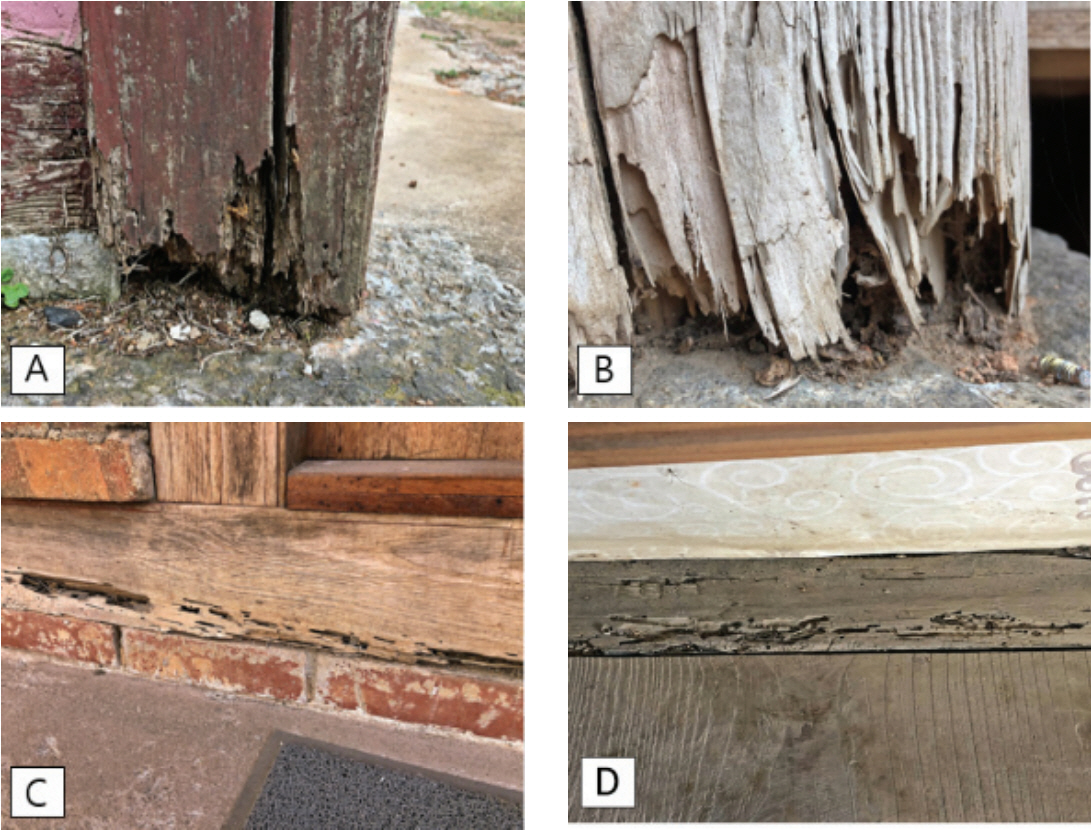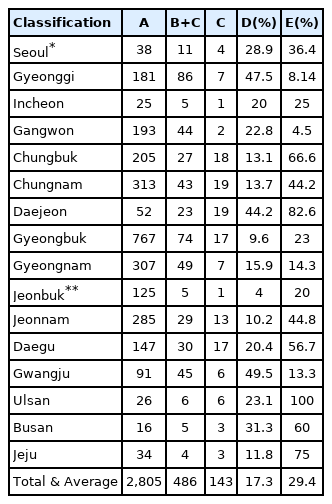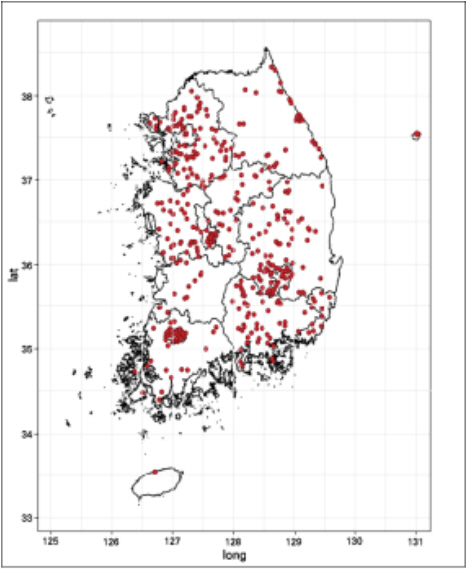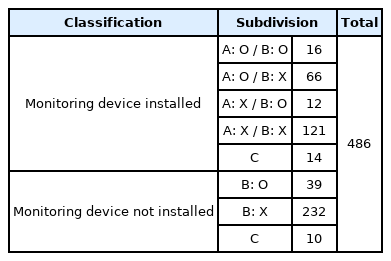국내 목조문화재에 대한 지중 흰개미 피해 및 모니터링 현황
The Status of Damage and Monitoring of Subterranean Termite (Reticulitermes spp.) (Blattodea: Rhinotermitidae) for Wooden Cultural Heritage in Korea
Article information
Abstract
본 연구에서는 전국 및 지역별 지중 흰개미 정기 모니터링 실시 기관들의 결과보고서를 바탕으로 국내 목조문화재의 지역별, 지정별 지중 흰개미 피해 및 관리 현황을 파악하였다. 또한 조사 내용들을 바탕으로 GIS 프로그램을 이용하여 전국 2,805건의 조사 대상 목조문화재에 대한 지중 흰개미 가해흔 및 가해 진행 현황 지도를 제작하였다. 현황 지도 제작 결과, 2018년∼2019년의 기간 동안 총 486건의 목조문화재에서 지중 흰개미 가해흔이 확인되었으며, 그중 143건(약 29.4%)에서 지중 흰개미 권역 유입 및 목부재 가해가 진행 중인 것으로 확인되었다. 위와 같이 조사된 피해 현황 자료의 접근성을 높이기 위하여 Map API를 활용한 웹 플랫폼 및 웹 어플리케이션을 제작하였다. 또한 기관별 결과보고서에서 확인된 지중 흰개미 모니터링 방안으로는 탐지견, 육안관찰, 예찰기, 극초단파 장비 등이 지중 흰개미의 유입 유무 파악 방안으로 적용되고 있으나 유입된 지중 흰개미 군체의 영역 범위를 판단할 모니터링 조사 방안은 현재 적용되고 있지 않은 것으로 확인되었다. 이에 따라 지중 흰개미 군체 모니터링 조사 시, 대상 목조문화재의 가해 영역 범위 산정 등 현황 파악을 위한 염색약 처리 및 Mark-Release-Recapture법의 적용이 필요할 것으로 판단된다.
Trans Abstract
In this study, the status of damage by subterranean termites and their management according to the region and type of domestic wooden cultural properties were identified. This was based on the survey reports of agencies conducting regular nationwide and regional monitoring of subterranean termites. In addition, using geographical information system (GIS) based on the survey contents, a map was constructed of termite infestation and its progress on 2,805 wooden cultural properties that were surveyed nationwide. Based on the map produced, a total of 486 cases of termite infestation were confirmed in wooden cultural properties during 2018-2019, of which 143 cases (approximately 29.4%) were confirmed to be owing to the invasion of termites in the ground and infestation of wood materials. A web platform and an application using a mapping application program interface were created to increase accessibility to the investigated damage status data. The methods employed by each institution for investigating and monitoring the invasion of termites in the ground included the use of detection dogs, visual observation, installation of wood specimens made of pine, and microwave equipment. However, it was confirmed that monitoring and survey methods were not applied to determine the territorial range of the subterranean termite colonies. Accordingly, the use of dyeing and mark–release–recapture methods were deemed necessary to understand the current status, such as calculating the scope of the target wooden cultural property, when monitoring subterranean termite colonies.
1. 서 론
지중 흰개미(Subterranean termite)는 인간이 거주하는 목조건축물을 가해하는 해충으로 전 세계적으로 매년 원화 약 44.5조의 비용이 흰개미를 방제 또는 피해 수리 및 복구에 사용된다(Rust and Su, 2012). 국내의 경우에도 2009년 기준, 전국 231개 목조문화재를 대상으로 지중 흰개미 피해 조사를 실시한 결과, 가해흔과 피해 진행이 확인된 건물이 다수 조사되었다(Kim et al., 2010; Manual of Cultural Heritage Biological Damage Management, 2012). 또한 최근에는 보물 1742호인 구리 숭릉 정자각이 지중 흰개미의 피해를 받아 전체 해체 보수가 결정되어 공사가 진행되었다(Cultural Properties Committee, 2019).
이에 따라 지중 흰개미에 대한 목조문화재의 피해 예방 및 방제를 위하여 방충방부제 도포, 군체 제거 장치설치, 토양 처리 등의 방법이 매년 지중 흰개미 방제를 위해 연구되어 목조문화재에 적용되고 있다(Im et al., 2019). 이러한 방제 방안의 적용에 따라 연간 국내에서 소요되는 비용은 2014∼2020년 문화재관리 재정현황을 기준으로 평균 약 15억4천만 원 정도로 확인되었다(Cultural Properties Committee, 2014; 2015; 2016; 2017; 2018; 2019; 2020).
지중 흰개미에 의한 피해는 지구 온난화, 산림의 비옥화, 현대식 구조의 변화 등의 요건들과 맞물려 그 피해가 가중되고 있으며(Manual of cultural heritage biological damage management, 2012), 국가 간 교역량 확대 등으로 인해 해외 수입품 통관 시, 외래흰개미의 검출, 유입사례가 증가하고 있다(Korea forest service, 2016). 이에 따라 지중 흰개미에 의한 목조문화재 피해를 예방하고 지속적으로 관리하고자 국립문화재연구소, 문화재돌봄사업단 등 문화재 관련 기관에서는 매년 정기적으로 대상 목조문화재의 지중 흰개미 모니터링을 실시하고 있으며, 조사 결과를 바탕으로 매년 결과 보고서 발간이 이루어지고 있다.
하지만 이러한 각 지역별 조사 자료를 통합한 전국 단위 지중 흰개미 피해 현황 자료 발간은 현재 수행되지 않고 있다. 그 결과, 국내에서는 현재 목조문화재의 지중 흰개미 피해가 진행 중인 것으로 인지되는 상황에 그칠 뿐, 전국 단위 피해 양상 및 그 심각성에 대한 종합적인 현황 파악이 어려운 실정이다.
이와 더불어 지중 흰개미 피해를 조사하기 위한 지중 흰개미 모니터링의 경우, 효율적인 방제 처리를 위한 현황 파악 과정으로 유입 지중 흰개미 군체의 대상 목조문화재 권역 내 활동 영역 및 이에 따른 가해 범위 산정이 가장 중요하다. 하지만 국내에서는 지중 흰개미 모니터링 조사 시, 탐지견, 목부재 육안 관찰, 소나무 재질의 예찰기(말목, HGM), 극초단파 탐지 장치 등을 이용한 유입 유무 조사만이 수행되고 있어 대상 목조문화재 권역 내 지중 흰개미 군체의 활동 영역 및 가해 영역 파악이 불가능한 실정이다.
따라서 본 연구에서는 국립문화재연구소, 문화재돌봄 사업단 등 매년 목조문화재 지중 흰개미 정기 모니터링을 실시하는 기관들의 결과보고서를 바탕으로 목조문화재의 지중 흰개미 피해와 예찰 현황을 파악하고자 하였다. 지중 흰개미 피해 현황은 전국 단위, 지역별, 지정별, 예찰기 설치 유무 등의 항목으로 분류하여 가해흔 및 가해 진행 현황을 분석하였으며, 문화재별 지중 흰개미 피해 현황을 지도로 표기하였다. 이와 더불어 국내의 기관별 지중 흰개미 모니터링 방안을 조사하여 분석함으로써, 국내 목조문화재 지중 흰개미 모니터링 조사 방안에 대한 문제점 및 개선점을 찾고자 하였다.
2. 조사 및 연구 방법
2.1. 국내 지중 흰개미 피해 현황 조사 및 분류
본 현황 조사의 대상 지역은 북위 33°∼39°로 제주도 및 울릉도를 포함한 대한민국 1개의 특별시, 6개의 광역시, 8개의 도, 1개의 특별자치도를 대상으로 하였다. 또한 본 연구의 지중 흰개미 피해 현황 자료는 국립문화재연구소 보존과학연구실, 안전방재연구실에서 발간된 ‘목조문화재 가해 생물종 조사 결과보고서’ 및 ‘국가지정 건조물 문화재(국보⋅보물) 정기조사’와 서울특별시 종로구, 세종특별자치시, 전라북도(동부권), 경상남도(동부권)을 제외한 전국 18개 문화재 돌봄사업단 결과보고서를 대상으로 현황 조사를 실시하였다(National Research Institute of Cultural Heritage, 2019, 2020; Gyeonggi Research Institute of Cultural Heritage, 2018, 2019; Incheon Cultural Heritage Preservation Corporation, 2018, 2019; Gangwon Cultural Heritage Research Institute, 2019; National University of Cultural Heritage Industrial-academic Cooperation Group, 2019; Chungnam Cultural Heritage, 2018, 2019; Chungbuk Cultural Heritage Research Institute, 2018, 2019; Baekje Cultural Center, 2018, 2019; Daedong Cultural Heritage, 2018, 2019; Chonbuk National University Industrial-academic Cooperation Group, 2019; Cultural Heritage Prevention and Management Center, 2018, 2019; Daegu Cultural Heritage, 2018, 2019; Ulsan Cultural Heritage Research Institute, 2018, 2019; Kyonam Cultural Heritage, 2019; Silla Cultural Center, 2019; Han Cultural Heritage, 2018, 2019; Gyeongnam Cultural Heritage Management Foundation, 2018, 2019; Busan Institute of Cultural Heritage and Technology, 2018, 2019; Jeju Cultural Foundation, 2018, 2019).
본 연구에서 참고한 문화재돌봄사업단의 결과보고서의 경우, 지역별 돌봄사업단에 따라 결과보고서 발간 및 지중 흰개미 모니터링 조사 시작 연도에 차이가 있는 것으로 확인되었다. 이에 조사 시기인 2020년 당시 지역별 돌봄사업단의 지중 흰개미 모니터링 결과보고서가 가장 많이 확보된 최근 2년(2018∼2019년)을 국내 목조문화재의 지역별 지중 흰개미 피해 현황 파악을 위한 조사 기간으로 선정하였다. 또한 조사 결과의 비교 기준이 되는 전국 지중 흰개미 모니터링 대상 목조문화재 총 건수는 문화재청 보존정책과에서 작성한 ‘2018∼2019년 문화재 돌봄사업 관리대상문화재 목록’을 참고하였다.
지중 흰개미 피해 현황 자료의 경우, 각 기관별 자료 중 지중 흰개미 가해흔이 확인된 목조문화재를 1차 분류한 뒤, 목부재, 주변 권역에서 흰개미 활성이 확인된 목조문화재를 대상으로 2차 분류하여 전국 단위, 지역별, 문화재 지정별 피해 현황을 파악하였다. 추가적으로 가해흔 및 지중 흰개미 활성이 확인된 목조문화재들에 대한 지중 흰개미 모니터링용 예찰기 설치 현황을 파악하여 예찰기 설치에 따른 모니터링 현황을 파악하고자 하였다.
2.2. 국내외 지중 흰개미 모니터링 방안 조사
현재 전국 및 각 지역별 야외 목조문화재를 대상으로 지속적인 지중 흰개미 정기 모니터링을 실시하고 있는 국립문화재연구소 및 전국 23개 중 18개 문화재돌봄사업단에서 발간된 자료를 바탕으로 현재 국내에서 적용 중인 흰개미 모니터링 방안을 조사하였다. 이와 더불어 1960년대부터 국외에서 수행된 지중 흰개미 모니터링 사례를 조사하여 모니터링 방안에 대한 비교 및 개선 사항을 확인하고자 하였다. 지중 흰개미 모니터링에 관한 국외 선행 연구의 모니터링 대상 종은 국내 서식 종과 동일 속인 Reticulitermes spp. 및 전 세계적으로 인간에게 가장 많은 경제적 피해를 주며, 앞으로 국내 유입 가능성이 높은 Coptotermes formosanus Shiraki를 대상으로 조사하였다(Lee et al., 2021).
2.3. GIS 프로그램을 활용한 데이터 시각화 및 지도 제작
2.1에서 언급한 여러 발간자료에서 조사된 전국의 국보 및 보물, 문화재 자료, 시⋅도유형문화재, 비지정 등을 대상으로 1) 지중 흰개미 가해흔 유무(지중 흰개미에 의한 목부재의 가해흔이 확인되었지만 목부재에서 지중 흰개미 활동이 확인되지 않음), 2) 지중 흰개미 가해 진행 중(목부재에 지중 흰개미 가해흔 및 흰개미 활동이 함께 확인) 등 2가지 조건으로 분류를 진행하였다. 이후 해당 자료들을 QGIS Desktop 3.10.11(Opensource) 프로그램을 통해 지중 흰개미 가해흔 및 가해 진행 중에 대한 현황 지도로 제작하였다. 또한 GIS 프로그램에서 활용한 전국 행정구역 단위 Country/province Shapefile은 GIS DEVELOPER (www.gisdeveloper.co.kr)에서 제공받아 사용하였다,
각 목조문화재에 대한 가해흔 및 가해 진행 중의 분류를 위해서 지중 흰개미 군체의 생태적 서식 반경 특성을 고려하여 구분하였다. 현재 국내에 서식이 확인된 Reticulitermes speratus의 경우, 해당 종에 대한 서식 영역 연구가 과거 진행되었지만(Tsunoda et al., 1999) 저농도 염색 및 장기간의 모니터링과 조사 범위 조건 등의 한계로 인해 해당 종의 군체 서식 영역 산정에 대한 추가 연구가 필요한 실정이다(Im and Han, 2020; Kim et al., 2020). 이에 따라 R. flavipes, R. virginicus, R. santonensis, R. hageni와 같은 동일 속의 국외 서식 종들을 대상으로 선행된 군체 서식 영역 범위 연구를 조사한 결과, 군체의 크기에 따라 30∼120 m까지 활동 영역이 확장되는 경향이 확인되었다(Grace et al., 1989; Grace, 1990; Su, 1993; Paulmier et al., 1997; Vargo, 2003).
해당 선행 연구에 따라 국내 서식 지중 흰개미가 속한 Reticulitermes spp.의 생태적 서식 반경 특성을 볼 때, 권역개념의 문화재 일부에서 지중 흰개미 피해가 확인되었을 경우, 인접한 주변 건물까지 서식 반경 내에 포함될 가능성이 높을 것으로 판단된다. 이에 따라 하나의 문화재명으로 지정되었으나 여러 채의 목조건축물로 구성된 권역개념 문화재의 경우, 조사된 구성 목조건축물들 중 한 곳이라도 가해흔, 권역 유입, 가해 중 등의 지중 흰개미 피해 조건에 포함되었다면 해당 문화재 권역 전체를 동일한 상황으로 분류하여 지도에 반영하였다. 또한 가해흔이 확인된 목조문화재 중 목부재에서는 지중 흰개미 활성이 확인되지 않았으나 목조문화재 둘레(예찰기) 및 권역(뗄감, 주변 그루터기 등)에서 지중 흰개미 유입 및 활성이 확인되었을 경우, 권역 유입과 목부재 내부에서 지중 흰개미활성이 확인된 경우를 동일하게 가해 진행 중으로 분류하여 지도에 반영하였다.
2.4. 맵API를 활용한 국내 목조문화재 지중 흰개미 모니터링 웹 지도 및 어플리케이션
2018∼2019년의 전국 지중 흰개미 피해 목조문화재 자료를 대상으로 가해흔, 가해 진행 중으로 분류된 대상 목조문화재의 위도 및 경도 등 위치 정보를 조사하였다. 이후 지도 제작을 위한 Map data는 Kakao Developers (https://developers.kakao.com)에서 제공하는 Map API (Opensource) 중 Web API를 사용하였다, 웹사이트 주소(http://termite.tes hi.net) 및 충북대학교 산학협력단 부설 문화재보존기술지원센터 홈페이지(http://conservation.cbnu.ac.kr)의 보존기술– 흰개미 방제 기술 연구 탭에 공개된 주소를 통해 모든 사용자가 단말기 및 PC로 접근 가능하도록 하였다. 이후 SWING2APP(https://swing2app.co.kr)에서 해당 웹사이트와 연동되도록 제작된 APK file을 스마트폰에 다운받아 웹 어플리케이션(Web Application)의 형태로 설치가 가능하도록 제작하였다. APK file을 통해 스마트폰에 다운로드된 어플리케이션으로 웹 브라우저 접속 및 주소 입력 단계 과정 없이 바로 웹사이트에 접속할 수 있도록 하였다.
3. 결과 및 고찰
3.1. 전국 지중 흰개미 분포 및 목조문화재 피해 현황(2018∼2019년 기준)
3.1.1. 전국 지중 흰개미 분포 및 피해 양상
1990년대 후반부터 현재까지 국내에서 진행된 선행 연구들을 살펴볼 때, 국내에는 Reticulitermes spp.의 지중 흰개미가 서울을 비롯한 충청도(공주, 부여, 서천, 세종, 강진), 전라도(군산, 익산, 임실, 완주, 김제), 경상도(부산, 양산, 진주, 울주, 남해, 산청, 하동, 경주, 울릉) 등에서 서식하는 것이 확인되어 전국적으로 분포하는 것이 확인되었다(Park, 1997; Lee and Jeong, 2004; Na et al., 2005; Park et al., 2013; Chung et al., 2015; Lee et al., 2015; Kim et al., 2017; Hwang et al., 2017; Park, 2019; Im and Chung, 2019; Im, 2019; Im and Han, 2020)(Figure 1).
국내에 주로 서식하는 Reticulitermes spp.의 지중 흰개미는 지중에 주요 서식처(Main nest)와 많은 수의 분화된 서식처(Satellite nest)로 군체의 구조가 형성되며, 먹이 탐색 구역들은 연결 통로를 통해 상호 연결되어 있다(Su, 1994). 또한 지중 흰개미는 먹이 탐색(Foraging)을 수행하는 일흰개미(Worker)가 탐색 및 목재를 섭식하는 과정에서 군체 영역이 확장되며 그 범위가 클 경우에는 100 m에 이른다(Su and Scheffrahn 1988, Grace et al. 1989, Su et al. 1993). 국내 서식 종과 동일 속인 R. flavipes의 경우에는 군체의 서식처 외부에서 먹이를 탐색하는 일흰개미의 개체 수가 군체 크기에 따라 평균 약 200,000∼5,000,000마리로 추정됨에 따라 실제 전체 군체의 개체 수는 이보다 더 많을 것으로 판단되며 먹이 탐색 거리는 직선거리로 79 m에 이른다(Grace et al., 1989). 국내 서식 종인 R. speratus의 경우에도 군체의 평균 개체 수는 100,000마리가 넘고 때로는 400,000마리 이상으로 성장하기도 한다(Tsunoda et al., 1999).
R. speratus는 목재 내부에 서식(Wood-dwelling)하고 지중을 통해 지면에 접해 있으며 동시에 함수율이 높은 건축물의 부재를 중심으로 가해한다(Buchli, 1956; Shimizu, 1970; Su, 1991). 국내 목조문화재의 주요 지중 흰개미 유입경로 또한 이와 동일하게 지중을 통해 기둥, 하인방, 신방목 등으로 유입되어 해당 부재들에 집중적인 피해를 일으키고 가해 정도가 더 심해질 경우에는 툇마루, 창방, 도리 등 점차 건물 위쪽의 목부재를 가해하기도 한다(Figure 2).
3.1.2. 전국 목조문화재 지중 흰개미 피해 현황
국립문화재연구소 및 전국 23개 중 18개 문화재돌봄사업단의 2018년, 2019년도 목조문화재 지중 흰개미 정기모니터링 결과보고서를 대상으로 전국 지중 흰개미 피해 목조문화재 건수 조사 결과는 다음과 같다. 해당 기간 조사된 총 2,805건의 목조문화재 중 목부재에서 지중 흰개미 가해흔이 확인된 문화재는 약 총 486건으로 전체 대상 건수에 약 17.3% 수준인 것이 확인되었다(Table 1, Figure 3). 지중 흰개미에 의한 가해흔의 경우, 본 조사 기간 이전에 생성된 것들도 다수 있을 것으로 사료된다. 하지만 과거 유입 시, 지중 흰개미 군체가 지중으로 연결되는 통로를 만들어 유입되었으므로 현재 흰개미 활성이 없더라도 유입에 필요한 환경 조건만 다시 갖춰진다면 재유입으로 인한 추가 훼손이 발생될 것으로 판단된다.
또한 가해흔이 발견된 486건의 목조문화재 중 예찰기, 주변 권역(그루터기, 뗄감, 인접한 숲) 및 목조문화재 목부재에서 지중 흰개미 개체가 확인된 곳은 143건(약 29.4%)으로 가해흔이 확인된 목조문화재 전체 건수에 약 3분의 1 수준인 것으로 확인되었다(Table. 1E, Figure 4). 해당 결과는 Kim et al.(2010)이 전국 16개 사찰을 대상으로 231개의 건축물 중 78개 건축물에서 가해흔을 확인하였으며, 이 중 흰개미에 의한 가해가 진행 중인 목조건축물의 비율은 약 7.8%라고 언급한 결과보다 약 3.3배 높은 결과이다. 이에 따라 전국의 목조문화재를 대상으로 발생하는 지중 흰개미 가해 진행 건수는 예상 수준보다 훨씬 더 심각한 것으로 판단된다.
3.1.3. 지역별 목조문화재 지중 흰개미 피해 현황
경기도(47%), 대전광역시(44%), 광주광역시(49%)의 경우, 지역별 조사 대상 목조문화재의 40% 이상이 지중 흰개미 가해흔이 있는 것으로 확인되었다. 또한 서울특별시, 인천광역시(20%), 강원도(22%), 대구광역시(20%), 울산광역시(23%), 부산광역시(31%) 지역에서도 각 지역별 전체 조사 대상 중 20%∼30% 정도의 목조문화재에서 지중 흰개미 가해흔이 확인되었다.
이와 더불어 충청북도(66%), 대전광역시(82.6%), 대구광역시(56.7%), 울산광역시(100%), 부산광역시(60%), 제주특별자치시(75%) 등의 지역은 가해흔이 확인된 목조문화재 중 목부재와 주변 권역에서 지중 흰개미 활성이 확인되는 건수가 50% 이상으로 확인되었다(Table 1, Figure 4).
이외에도 서울특별시(28%), 인천광역시(25%), 경상북도(23%), 전라북도(20%) 등의 지역에서 가해흔 확인 목조문화재의 약 20%에서 흰개미 활성이 확인되었다. 따라서 지중 흰개미유입에 의한 목조문화재의 피해는 지역에 차이 없이 전국적으로 일어나는 것으로 판단된다(Table 1, Figure 3).
하지만 울산광역시(100%), 부산광역시(60%), 제주특별자치시(75%), 서울특별시(36%), 인천광역시(25%)의 경우, 각 지역의 모니터링 대상 목조문화재 건수가 50건 미만이기 때문에 다른 지역과 동일한 피해 진행 건수라도 상대적으로 높은 비율로 계산되었다. 이에 향후 해당 지역의 지중 흰개미 모니터링 조사 건수를 높인다면 실제 해당 지역에 대한 지중 흰개미 피해 비율에 변화가 있을 것으로 판단된다.
3.1.4. 지정별 목조문화재 지중 흰개미 피해 현황
2018∼2019년에 실시된 지중 흰개미 모니터링 대상 국가 지정 목조문화재는 국보, 보물 및 국가민속문화재 등 총 477건으로 이 중 28%인 134건의 목조문화재에서 지중 흰개미 피해가 확인되었다(Table 2). 가해흔이 확인된 134건의 국가지정문화재 중 약 31.3%가 목부재 및 권역에서 흰개미 활성이 확인되었다. 이와 더불어 시도지정문화재의 경우, 총 1,649건 중 282건으로 약 17.1%의 가해흔이 발견되었고 이 중 27.7%인 78건에서 지중 흰개미 활성이 목부재와 권역에서 확인되었다(Table 2). 이외에 지역별로 모니터링을 실시한 비지정 목조문화재들은 전체 679건 중 70건으로 약 10.3%의 가해흔이 확인되었고 이 중 32.9%에 해당하는 23건에서 지중 흰개미 목부재 및 권역 유입이 확인되었다.
3.1.5. 예찰기 설치에 의한 지중 흰개미 모니터링 조사 현황
지중 흰개미 피해가 확인된 486건의 목조문화재를 대상으로 현재 모니터링 조사 현황을 조사한 결과, 전체 486건의 가해흔 확인 목조문화재 중 44.6%인 215건만이 예찰기 설치를 통한 지중 흰개미 유입 모니터링을 실시하고 있었다(Table 3). 이를 제외한 나머지 271건(55.4%)에서는 예찰기 설치 없이 육안관찰 및 주변 환경 조사에 의한 모니터링만을 실시하고 있는 것으로 확인되었다. 따라서 가해흔이 확인된 목조문화재의 경우, 지중을 통해 이동하는 지중 흰개미 군체의 유입 현황을 외부에서 파악하기 어렵기 때문에 의무적으로 둘레에 예찰기 설치를 통한 모니터링을 실시해야 할 것으로 사료된다. 또한 이와 같은 예찰기 설치 현황으로 미루어 볼 때, 예찰기를 설치하지 않은 가해흔 확인 목조문화재에 예찰기 설치를 실시한다면 보다 면밀한 유입 현황 파악이 가능할 것으로 판단된다.
이외에 이번 조사에서 파악된 2,805건의 전체 모니터링 목조문화재 건수는 서울특별시, 세종특별자치시, 전라북도(동부)를 담당하는 조사 기관의 발간 자료 비공개 등으로 인해 해당 지역의 목조문화재에 대한 지중 흰개미 피해 현황 자료가 반영되지 않은 결과이다. 따라서 자료 비공개 지역들의 피해 조사 결과까지 합한다면 전국적으로 더욱 많은 건수의 목조문화재가 지중 흰개미에 의한 피해를 이미 입었거나 입고 있을 것으로 판단된다(Table. 1, Figure 3, 4).
하지만 본 조사를 통해 확인된 목부재 가해흔 및 가해 진행 중(목부재 직접 가해, 권역 유입)인 기관별 발간 자료 결과를 종합해 볼 때에도 전국적인 피해 경향의 파악은 가능할 것으로 사료된다. 따라서 조사 결과들을 종합해 볼 때, 2019년 기준으로 전국은 북위 36° 이하의 비교적 따뜻한 지역 이외에 강원도와 같이 북위 38° 이상의 지역에서도 Reticulitermes spp. 지중 흰개미에 의한 목조문화재 가해가 전국적으로 활발하게 진행되고 있는 것으로 판단된다(Figure 4).
3.2. 지중 흰개미 모니터링 웹 지도 및 어플리케이션
지중 흰개미 정기 모니터링 실시 기관의 발간 자료를 바탕으로 지중 흰개미에 의한 피해가 확인된 전국의 목조문화재 486건을 대상으로 모니터링 웹 지도 및 어플리케이션 제작을 실시하였으며, 마커 클러스터러(Marker Clusterer)를 활용하여 지도의 확대 정도에 따라 지역별 지중 흰개미 가해 목조문화재 건수를 직관적으로 확인할 수 있도록 하였다(Figure 5A). PC 및 스마트폰 어플리케이션을 통한 웹 지도 접속 시, 기본 화면에서는 전국 단위 지중 흰개미 피해 목조문화재 건수를 확인할 수 있도록 구획화하였다(Figure 5A, 6A). 또한 조사 연도, 가해흔과 가해 진행 대상에 따른 1차 분류가 가능하도록 하여 선택 연도별 가해흔이 확인된 목조문화재 중 지중 흰개미에 의한 가해가 진행 중인 목조문화재를 확인 가능하도록 하였다(Figure 5B, 6B). 가해 진행 유무에 따른 분류 후에는 문화재보호법에서 규정한 문화재 분류 기준에 따라 선택할 수 있도록 분류 체계를 구성하여 전국 단위, 지역별 문화재 지정 종류에 따른 지중 흰개미 피해 현황을 확인할 수 있도록 하였다(Figure 5C, 6C). PC 버전에서는 확대된 개별 마커(Marker)에 마우스 커서를 올려놓을 경우, 해당 문화재 지정명 정보가 인포 윈도우(Info Window)의 형태로 나타나도록 하였고, 클릭 시에는 문화재청 국가문화유산 포털의 해당 문화재 정보로의 연계되도록 하였다(Figure 5D).
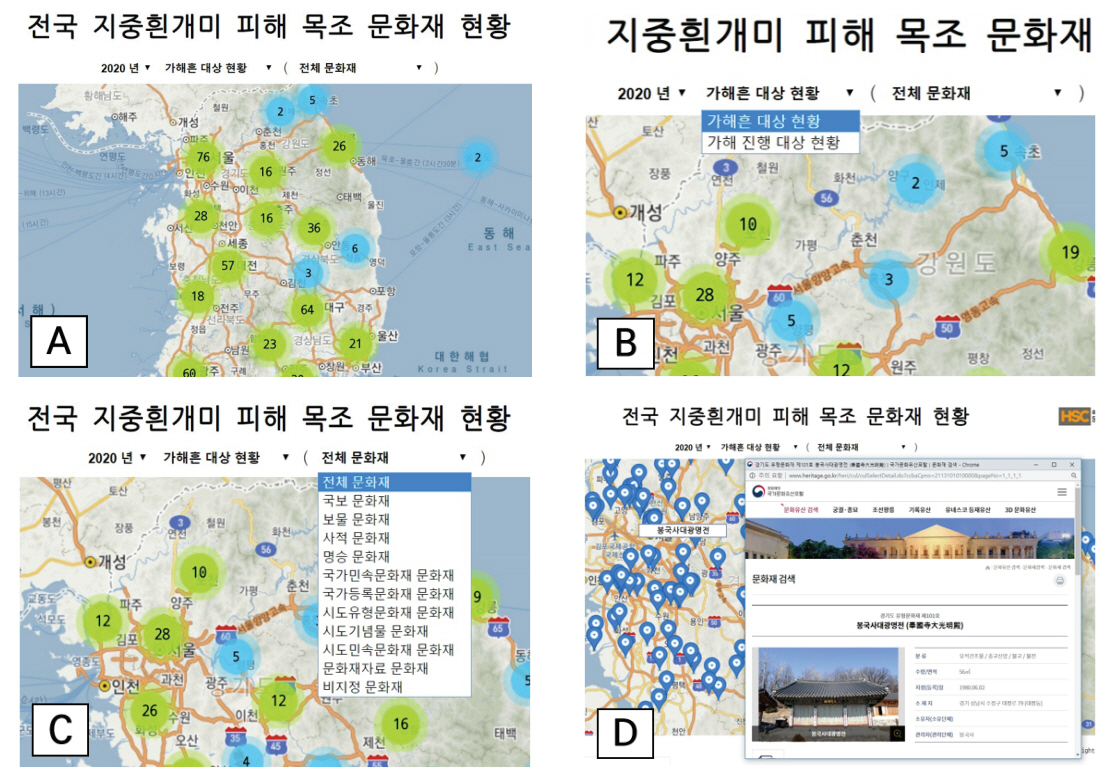
Web monitoring program for wooden property nationwide damaged by subterranean termite. (A) Initial screen. (B, C) Classification screen. (D) Information site linkage.
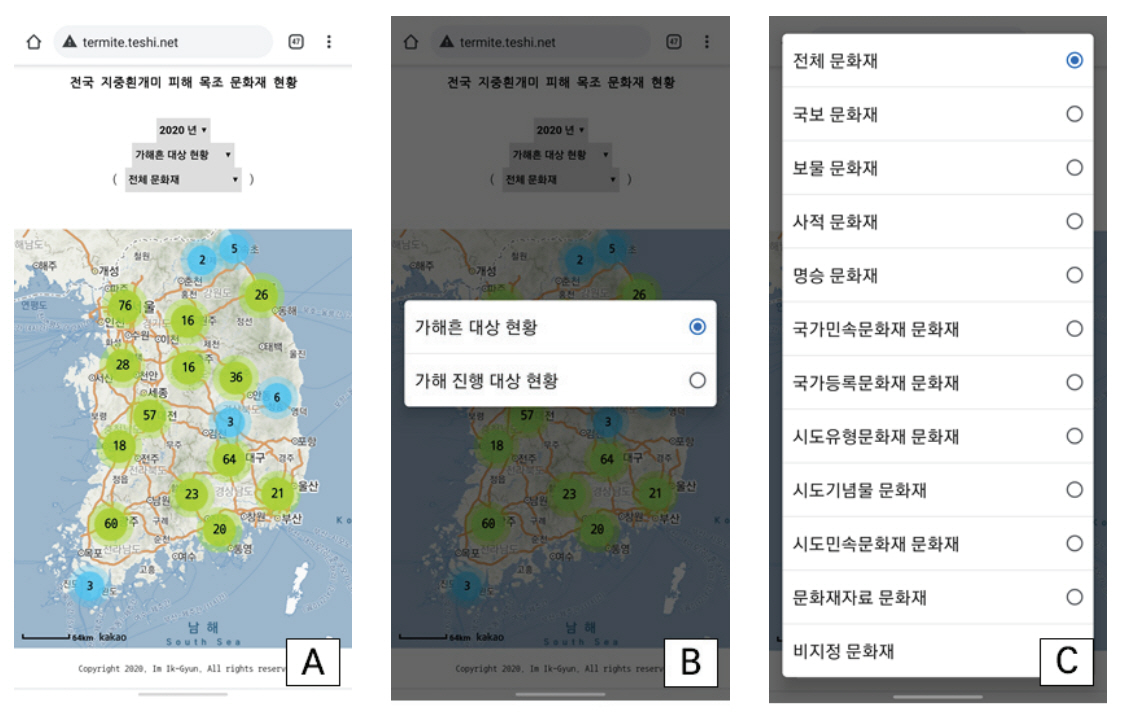
Web applications for wooden property nationwide damaged by subterranean termite. (A) Initial screen. (B, C) Classification screen.
향후 국립문화재연구소, 전국문화재돌봄사업단 등에서 발간되는 목조문화재 지중 흰개미 정기 모니터링 발간 자료를 활용하여 위와 같은 웹 기반 지중 흰개미 모니터링 현황 지도를 지속적으로 최신화한다면 보다 효율적이고 직관적인 전국 단위 지중 흰개미 피해 현황 파악이 가능할 것으로 판단된다.
3.3. 국내외 지중 흰개미 모니터링 방안 조사
3.3.1. 국내 지중 흰개미 모니터링 현황
(1) 육안 관찰 및 탐지견을 이용한 모니터링
국립문화재연구소 및 전국 18개 문화재돌봄사업단의 지중 흰개미 모니터링 조사 방안 조사 결과, 각 조사 기관별 목조문화재 지중 흰개미 모니터링 방법에 차이가 확인되었다(Table 4).
문화재돌봄사업단의 경우에는 18개 지역별 문화재돌봄사업단에서 모두 육안관찰을 통한 목조문화재 지중 흰개미 가해흔 관찰을 실시하고 있었다. 이 중 일부의 단체에서 모니터링을 위해 설치한 목재 예찰기 내부의 효율적인 지중 흰개미 군체 유입 확인을 위해 예찰기에 천공을 실시 후, 내시경 촬영을 실시하는 것으로 확인되었다(Table 4). 목조문화재를 대상으로 한 여러 지중 흰개미 비파괴 조사에서 활용된 내시경 카메라는 현장에서 효율적이고 간편하게 목조문화재의 피해 부재 및 모니터링 예찰기에 물리적인 이동 및 변형을 가하지 않고 유입 여부를 확인할 수 있는 장치이다(Son and Lee, 2008). 이에 따라 해당 장치를 보다 많은 지중 흰개미 피해 모니터링 단체에서 조사에 활용한다면 효율적이고 신뢰도 높은 조사 결과가 도출될 것으로 판단된다.
이외에 탐지견을 이용한 지중 흰개미 피해 모니터링 방법은 국립문화재연구소 보존과학연구실에서 삼성생명과 협업을 통해 국내 지중 흰개미 모니터링 기관 중 유일하게 진행 중인 것으로 확인되었다(Jeong, 2010; Kim et al., 2019). 또한 탐지견으로 탐지된 지중 흰개미 가해 목부재의 함수율, 건물 자체의 난방과 거주 유무, 기상 인자 등의 서식 환경 분석을 실시하여 흰개미 피해와 목조건축물의 환경 요인들 간의 상관성을 분석하는 것으로 확인되었다(Seo et al., 2015; Kim et al., 2019; Lim et al., 2019).
(2) 예찰기를 이용한 모니터링
1930∼1960년대 당시에는 지중 흰개미의 모니터링 방안이 개발되지 않았기 때문에 여러 가지 알려지지 않은 생태적인 행동의 연구를 위해서 직접 굴착을 통해 군체의 내부 구조 및 범위를 조사하였다(Erhorn, 1934; Greaves, 1962; King, 1969). 이후 1980∼90년대에는 목재 예찰기(Wood stake)를 지중에 설치 후, 월 단위로 지중에서 빼내 지중 흰개미 가해 유무를 확인하였으며, 지중 흰개미 군체 유입으로 기존 목재 예찰기의 가해가 심각할 경우에는 새로운 목재 예찰기로 교체해주는 방안(Su, 1988, 1993; Thorne et al., 1996; Tsunoda et al., 1998, 1999)이 지중 흰개미 모니터링 연구에 적용되었다. 국내에서도 사적 제504호 해인사 권역 내에서 지중 흰개미 서식이 확인됨에 따라 1998년부터 2002년까지 목재 예찰기를 이용하여 모니터링을 실시하였다(Jeong et al., 2002).
1990∼2000년대에는 주된 국내 지중 흰개미 방제 방안으로 훈증 및 토양처리가 적용되고 있었다. 하지만 해당 방안들은 사회성 곤충인 지중 흰개미의 방제가 불가능한 것으로 판단하여 당시 국립문화재연구소에서는 미국 Dow agroscience社(現 Corteva社)에서 새롭게 지중 흰개미 군체 제거용으로 개발된 센트리콘 시스템(Sentricon system global in-ground type)을 2000∼2001년(약 17개월)의 기간 동안 종묘 주변 수림지역에 국내 최초로 설치하여 적용 가능성을 확인하였다(Jeong et al., 2002). 이후 센트리콘 시스템은 2010년대 초반까지 보물 제664호 청주 안심사대웅전을 비롯한 다수의 목조문화재에 지중 흰개미 군체 방제 및 모니터링을 위해 적용되었다.
이후 2014년 문화재청 산하 기관인 한국전통문화대학교에서 지중 흰개미 모니터링 및 방제용 예찰제어기인 HGM 예찰기가 개발되어 송광사, 해인사 등 목조문화재에 적용되었으며(Chung et al., 2015), 현재까지 목조문화재 지중 흰개미 방제에 전국적으로 사용되고 있다. 이에 따라 2000년 종묘에 최초 적용을 시작으로 국내에 유통되고 있던 센트리콘 시스템은 HGM 예찰기가 개발되어 상용화된 2015년도 이후 국내에서 사라졌으며, 목재 및 HGM 예찰기 2가지 종류의 장치만이 국내에서 지중 흰개미 모니터링에 사용되고 있다. 이에 따라 본 연구에서 조사된 18개의 지역별 문화재돌봄사업단 중 16개 돌봄사업단의 경우에도 대상 목조문화재 둘레 및 권역에 소나무 재질의 말목 예찰기 및 HGM 예찰기를 설치하여 지중 흰개미 모니터링을 진행하고 있는 것이 확인되었다.
하지만 일정 기간마다 지중 흰개미 유입 유무 관찰 및 가해에 의한 예찰기 자체의 내구성 하락으로(Chung et al., 2015) 예찰기 교체를 위해 지중에서 예찰기 자체를 빼내 것으로 확인되었다. 이와 같이 예찰기를 지중에서 빼내는 모니터링 및 교체 과정은 지중과 예찰기 사이에 연결된 군체의 의도(Tunnel) 파괴한다. 또한 군체 자체의 위험 감지로 유인력이 감소되어 목조문화재에 지중 흰개미 군체가 유입되었음에도 설치된 예찰기로 유인되지 않아 효과적인 모니터링이 불가능하게 될 것으로 판단된다(Tsunoda et al. 1999; Sattar et. al., 2007). 이러한 예로 경상북도 민속 문화재 제98호 화기리 인동 장씨 종택 및 경상북도 문화재자료 제445호 봉화 팔오헌 종택과 같이 말목 예찰기에서 개체 유입이 확인되지 않았으나, 4월∼5월에 대상 목조문화재에서 군비가 발생하는 상황을 예로 들 수 있다(Han cultural heritage, 2019).
따라서 지중 흰개미 군체 모니터링 시에는 모니터링 장치 자체를 지중 흰개미 먹이원으로 구성하여 일정 기간 마다 교체하는 방안은 피해야 하며 해외의 지중 흰개미 모니터링 장치 개발 사례와 같이 내구성 있는 외부 프레임으로 제작된 장치의 도입이 필요할 것으로 판단된다. 이를 통해 스테이션 자체에 물리적 변형 없이 내부 먹이원의 투입 및 교체를 실시한다면 유입된 지중 흰개미의 의도를 파괴하지 않으면서도 지속적인 유입 현황을 관찰할 수 있을 것으로 판단된다(Figure 7A, B).
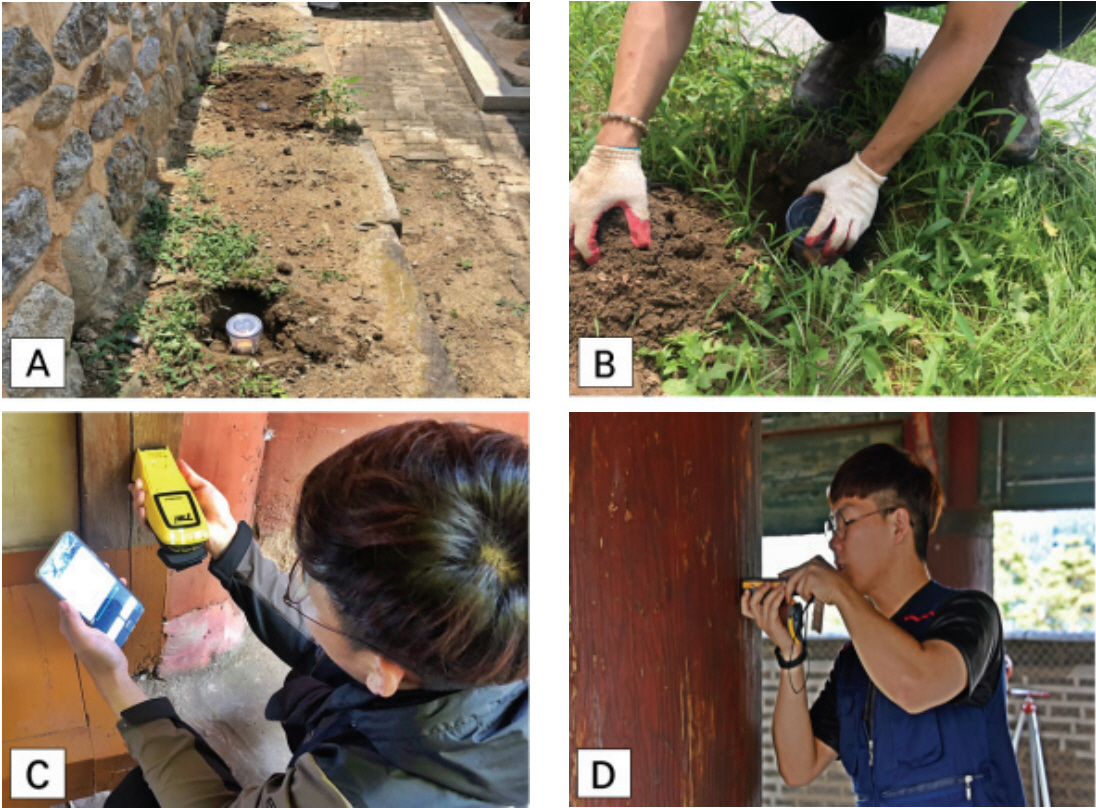
Subterranean termite monitoring method. (A, B) Monitoring Station Installation for monitoring and control. (C) Termatrac. (D) Wood Moisture content.
이와 더불어 지중 흰개미 모니터링의 시기 또한 9월 말 이후에는 계절적 요인으로 인하여 평균 온도가 하락함에 따라 지중 흰개미 군체의 활동 유무 파악이 어려워진다. 따라서 지중 흰개미 모니터링 시기를 3∼9월(약 6개월)로 설정하고 해당 기간 내에 조사를 집중적으로 실시하여 대상 목조문화재들의 지중 흰개미 유입 및 가해 유무를 파악하는 것이 보다 신뢰성 있는 조사 결과가 도출될 것으로 판단된다.
(3) 극초단파 탐지 장치를 이용한 모니터링
극초단파(Microwaves)를 통해 다양한 재질들 내부의 움직임을 탐지할 수 있는 비파괴 탐지 장비인 Termatrac (Termatrac Co., AUS)은 1999년 1세대 장치인 Termatrac T1r이 출시되었으며(Taravati, 2018), 해당 모델을 통한 흰개미 탐지 기술 연구가 국외에서 2010년까지 수행되었다(Evans 2002; Lewis and Tabuchi, 2010; Hickman and Forchler, 2012). 이후 2010년에는 감온 센서, 습도 센서가 추가적으로 장착되어 기존의 극초단파 레이더까지 총 3가지 장치가 내장된, 2세대 모델인 Termatrac T3i가 출시되었다(Barway et al., 2015; Taravati, 2018).
국내에서는 2010년 1세대 모델인 Termatrac T1r을 대상으로 국내 지중 흰개미에 대한 수종별, 개체 수에 따른 실내 적용 평가 및 실제 목조문화재 목부재를 대상으로 현장 적용을 통한 비파괴 진단 방안 연구가 진행되었다(Kim et al., 2010), 이후 2010년에 2세대 모델인 Termatrac T3i가 출시되어 국내에서는 목조문화재를 대상으로 한 지중 흰개미 유입 비파괴 조사에서 해당 장비의 사용 빈도가 증가되었다(Table 4). 이에 따라 실제 목조문화재 목부재에 적용 시, 해당 장치의 측정 범위, 측정 방법, 유의사항 등을 제시한 극초단파 장비의 목조문화재 지중 흰개미 탐지 방안 기준 마련 연구가 진행되었다(Im, 2019) (Figure 7C).
전국 18개 지역별 문화재돌봄사업단 중 10개의 단체에서 지중 흰개미 가해가 의심되는 목부재를 대상으로 2세대 극초단파 탐지 장치 Termatrac T3i를 이용한 지중 흰개미 가해 진행 여부 파악을 수행하고 있는 것으로 확인되었다(Figure 6C, Table 4). 하지만 측정 당시 해당 장치에 대한 측정 간격 및 방법 등 측정 조건이 결과보고서에 기재되어 있지 않아 기관별 측정 자료 결과에 대한 표준화가 어려울 것으로 판단되어 이에 대한 측정 당시 기준들을 보고서에 명시해야 할 것으로 사료된다. 또한 해당 2세대 모델의 건재흰개미 탐지 최대 깊이에 관한 기준 연구는 3.5∼5.0 cm 범위로 수행되었으나(Lewis et al., 1998; Taravati, 2018) 상대적으로 건재흰개미보다 함수율이 높은 목재를 가해하는 지중 흰개미 가해 환경에 따른 수종별 최대 탐지 깊이 및 범위 연구가 진행되지 않은 실정이다.
이에 따라 실제 목조문화재를 대상으로 여러 직경의 피해 목부재에 적용할 경우, 일정 규격 이상의 깊이에서는 내부에 흰개미 개체가 존재함에도 극초단파 레이더에 탐지되지 않는 어려움이 있을 것으로 판단된다. 따라서 향후 2세대 모델을 대상으로 조건별 탐지 범위, 깊이 등에 대한 연구 수행을 통한 기준 정립 연구가 필요할 것으로 사료된다.
3.3.2. 국내 미적용 모니터링 기술
지중 흰개미 모니터링 및 방제 스테이션 장치를 설치하여 단순히 유입 유무를 파악하는 것에서 나아가 Fujii(1975)에 의해 지중 흰개미인 Coptotermes formosanun Shiraki를 대상으로 유입 군체의 수, 영역 등을 파악하기 위한 염색약(Dye Marker) 연구가 처음으로 진행되었다, 해당 적용 연구를 시작으로 Sudan Red 7B, Nile Blue A, Neutral Red와 같은 다양한 색상의 염색약을 대상으로 지중 흰개미 종별 적용 가능성 및 적정 농도 연구가 진행되었다(Fujii, 1975; Su et al., 1983, 1988; Grace et al., 1989; Grace and Abdallay, 1990; Forschler, 1994; Thorne et al., 1996; Evans, 2000; Atkinson, 2000, 2004a, 2004b; Nobre et al., 2007). Reticulitermes spp., Coptotermes spp. 등에 대한 염색약의 적용성 연구로 Sudan Red 7B, Nile Blue A, Neutral Red 등의 적용 가능성을 확인된 이후에는 해당 염색약들을 활용하여 MRR (Mark-Release-recapture) Method로 군체의 영역 범위(Territory) 및 크기(Population)를 산정하는 현장 적용 연구(Su, 1988, 1993; Forschler and Townsend, 1996; Thorne et al., 1996; Tsunoda et al., 1998, 1999; Evans et al., 1999; Messenger et al., 2005; Nobre et al., 2007, Su et al., 2016)가 활발히 진행되었다.
지중 흰개미 군체 유입이 확인된 모니터링 스테이션 간 상호 연결 유무를 염색 개체의 채집 및 방사를 통해 확인하는 방법인 MRR Method의 경우(Su, 2019), 효과적인 모니터링을 위해 개발된 모니터링 스테이션 장치와 개체 염색을 활용하여 전체 구역을 대상으로 구역별 유입된 지중 흰개미 군체의 수와 해당 군체별 영역 범위 변화 등을 파악할 수 있는 장점이 있다(Evans, 2001). 이에 따라 국외에서는 지중 흰개미가 가해 중인 대상 구역 내 지중에 설치된 모니터링 스테이션을 이용한 MRR Method 적용을 통해 지중 흰개미 군체 유입 현황 파악, 방제 처리 후 대상 군체의 활성 감소 등의 다양한 모니터링 연구가 진행되었다(Su, 1988, 1993; Forschler and Townsend, 1996; Thorne et al., 1996; Tsunoda et al., 1998, 1999; Getty et al., 2000; Evans, 2001; Messenger et al., 2005; Nobre et al., 2006, Su et al., 2016). 이와 더불어 지중 흰개미 유입으로 인해 훼손되고 있는 국외의 역사적인 건축물 및 기념물 등과 같은 문화유산을 대상으로 MRR Method를 활용한 지중 흰개미 군체의 시기별 활성도와 영역 범위 모니터링 및 방제 처리 후, 약제 효과 발현에 따른 군체의 개체 수 감소 경향을 확인하는 연구가 진행되었다(Su and Scheffrahn, 1986; Su et al., 1998, 2002; Ferrari and Marini, 1999; Gambetta et al., 2000; Su and Hsu, 2003).
그러나 염색 및 MRR Method를 이용한 지중 흰개미 군체의 영역 산정 및 모니터링 방안은 지금까지 국내 목조문화재 혹은 목조건축물의 지중 흰개미 모니터링 현장에 적용되지 않은 실정이다. 이에 따라 해당 분야에 지중 흰개미 군체의 유입 경로 및 영역 확인 등에 활용할 MRR Method의 국내 적용을 위해 염색약에 대한 연구가 진행되었다(Kim et al., 2014, 2020; Im and Han, 2020). 이와 같은 국내 서식 지중 흰개미에 적합한 염색약 및 농도 조건 선정 연구 이후에는 실내외 지중 흰개미 군체를 대상으로 선정 약제의 적정 농도 조건별 MRR Method 적용성 평가가 진행되어야 할 것으로 판단된다.
4. 제 언
최근 2년(2018년, 2019년) 간의 지중 흰개미 모니터링에 대한 기관별 결과보고서들을 종합한 결과, 지역의 구분 없이 전국적으로 목조문화재에 대한 지중 흰개미 피해가 확인되었다. 따라서 지중 흰개미에 대한 목조문화재 피해를 줄이기 위한 지속적인 모니터링 및 방제 처리가 필요하다.
또한 이번 연구를 통해 제작된 ‘전국 목조문화재 지중 흰개미 피해 현황’ 웹 지도를 통해 향후 지속적인 연도별 자료의 축적을 실시한다면 모니터링 및 방제 시, 보다 효율적이고 직관적인 현황 파악이 가능할 것이다. 이러한 현황 자료를 기초로 하여 지역별 통합적인 모니터링 및 방제 체계를 구축해 나간다면 향후 지중 흰개미에 의한 목조문화재 피해를 최소한으로 줄일 수 있을 것이다.
기관별 조사 자료 검토를 통한 모니터링 조사 방안 파악 결과, 전국적으로 지중 흰개미에 의한 목조문화재 가해흔 및 가해 진행 양상이 확인되고 있는 상황이지만 국내에서는 목재 및 HGM 예찰기를 통한 유입 유무만을 확인할 뿐 지중 흰개미 군체의 서식 및 활동 현황들을 효과적으로 모니터링할 수 있는 방안들이 적용되고 있지 않은 것으로 확인되었다. 이에 따라 국외의 사례와 마찬가지로 유입된 군체의 수, 영역 범위 등의 현황 조사를 통한 가해 영역 범위 산정이 가능하도록 국내 서식 지중 흰개미에 대한 적정 염색약 및 농도 선정과 MRR Method의 적용 연구가 진행되어야 할 것으로 판단된다. 또한 현재 목조문화재 목부재를 대상으로 적용되고 있는 극초단파 장비의 적용 목부재 유형별 기준 연구를 진행하여 지역별 대상 목조문화재의 지중 흰개미 유입 측정 결괏값에 대한 신뢰성 확보가 필요할 것으로 사료된다.
이와 더불어 지역별 지중 흰개미 피해에 대한 목조문화재의 조사 건수가 10건 내외로 적거나 발간 자료의 공개를 하지 않는 조사 기관들이 확인됨에 따라 올바른 피해 현황 파악을 위해 지중 흰개미 피해 모니터링을 실시하는 대상 목조문화재의 증가 및 발간 자료의 원활한 공개 절차 마련이 시급한 것으로 판단된다.
